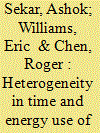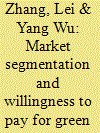|
|
|
Sort Order |
|
|
|
Items / Page
|
|
|
|
|
|
|
| Srl | Item |
| 1 |
ID:
150900


|
|
|
|
|
| Summary/Abstract |
There is substantial variability in residential energy use, partly driven by heterogeneous behavioral patterns. Time-use is relevant to energy when consumption tracks the time a device is used. Cluster analysis is a promising approach to identify time-use patterns. If clusters with particularly long time use and thus high energy consumption emerge, these groups could merit targeted policy intervention. We investigate these ideas via an empirical study of time use for television watching in the U.S. Three clusters were identified. In 2013, the average time spent watching television by Clusters 1, 2 and 3 are dramatically different: 1.1, 3.5 and 7.7 h per day respectively. While members of Cluster 3 are only 14% of the total population they represent 34% of TV energy consumption. The population of Cluster 3 tends to be older, less employed and less educated. Energy savings per adopter is much larger for Cluster 3, suggesting much higher benefits from efficient devices. These results are relevant to the design of efficiency programs, indicating potential for variable rebates and/or tiered communication. With variable rebates, utilities would offer higher incentives to high-use customers. In tiered communication, utilities would devote more resources to engage customers with larger savings potential.
|
|
|
|
|
|
|
|
|
|
|
|
|
|
|
|
| 2 |
ID:
116968


|
|
|
|
|
| Publication |
2012.
|
| Summary/Abstract |
The objective of this study is to identify market segments and estimate the residents' willingness to pay (WTP) for green electricity (green-e) in China for the large-scale promotion of energy projects from renewable sources that do not rely solely on energy policies. Based on an analysis of non-use values of green-e as well as the application of the contingent valuation (CV) method and payment card (PC) introduction technology, the average WTP ranges from RMB 7.91 yuan/month to 10.30 yuan/month (approximately US$ 1.15-1.51/month with an exchange rate of 6.83 yuan/US$ yuan/US$) for urban residents in Jiangsu Province. The current work also explores the differences in demographic variables across varying WTP amounts and the different marginal effects of demographic variables at the same level of WTP. The findings reveal that there are significant differences in demographic variables, such as level of education, household income and location of residence, across the population segments. Moreover, the finding that some respondents with high income and higher education prefer higher WTP amounts to lower WTP amounts suggests that green-e is a luxury product, and consequently, a Veblen effect exists in certain Chinese market segments.
|
|
|
|
|
|
|
|
|
|
|
|
|
|
|
|
| 3 |
ID:
167038


|
|
|
|
|
| Summary/Abstract |
China's wind power has experienced explosive growth and reshaped the overall energy mix since 2009. However, increasing investment in the wind power industry has been accompanied by persistent and serious wind curtailment since 2010, leading to significant efficiency loss. This paper argues that the interprovincial market segmentation, which is driven by political motivations, is a key factor contributing to wind curtailment. We first construct an interprovincial electricity market segmentation index. This is then used as an independent variable to explain the variation in wind curtailment rates. A panel dataset of 28 provinces during the 2009–2016 period is used for empirical analysis. The results clearly show that market barriers positively contribute to wind power curtailment. Specifically, a 10% decrease in the market segmentation index will lead to a 4.3–5.3% decrease in wind power curtailment.
|
|
|
|
|
|
|
|
|
|
|
|
|
|
|
|
| 4 |
ID:
125521


|
|
|
|
|
| Publication |
2013.
|
| Summary/Abstract |
We estimate the gross margin that is earned from the supply of electricity to households in Ireland. Using half hourly electricity demand data, the system marginal price (also called the wholesale price) and the retail price of electricity, we analyse how the gross margin varies across customers with different characteristics. The wholesale price varies throughout the day, thus, the time at which electricity is used affects the gross margin. The main factor in determining gross margin, however, is the level of demand.
The highest gross margins are earned from supplying customers that have the following characteristics: being aged between 46 and 55, having a household income of at least €75,000 per annum, being self-employed, having a third-level education, having a professional or managerial occupation, living in a household with seven or more people, living in a detached house, having at least five bedrooms or being a mortgage holder.
An OLS regression shows that gross margin is partly explained by the energy conservation measures which are present in a household; the number of household members; the number of bedrooms; age; occupation; and accommodation-type.
|
|
|
|
|
|
|
|
|
|
|
|
|
|
|
|
|
|
|
|
|